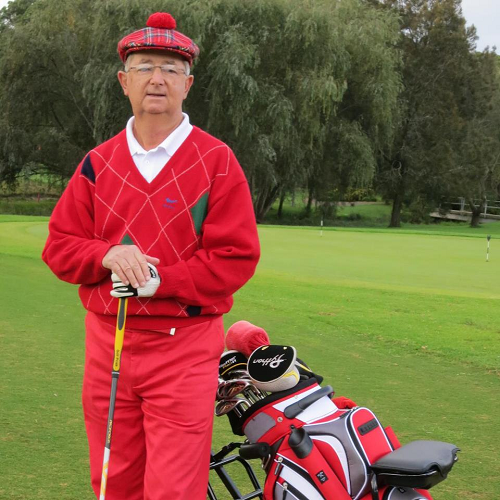About Me
Greg Hartshorne
Cricket CoachSydney, New South Wales, Australia
0408719956
Played Sydney Grade Cricket from 1969 to 1999. Foundation life member of Randwick Petersham Cricket Club
Partner Sponsors
My Activity
answered
Q: Who is the one player from Sydney Grade Cricket who played between 1980 and 2000 you’d want as the first player selected if you had the opportunity to start your own NSW Premier first grade cricket team?
A: Dave Chardon. Right arm quick who took more 1st wickets than any player throughout the 70s and 80s. Always got into the top order on any type of wicket.
answered
Q: Why do captains or spinners in the modern game tend to bowl with a deep point.
When I bowling there were many times, I beat the batsman in flight and bounce they were caught at point driving or cutting. I always thought the deep point was setting a field for bad bowling.
Why have things changed?
When I bowling there were many times, I beat the batsman in flight and bounce they were caught at point driving or cutting. I always thought the deep point was setting a field for bad bowling.
Why have things changed?
A: Totally agree.
The ring field seems to have disappeared. Deep point, deep mid on or off. So many easy singles these days. Why not force the batter to hit over the top, or against the spin through point
Playing in England with a number of quality offies, they taught me the 3 - 6 field. Only point, cover, and mid-off. Leg side - shortish backward square, silly mid-on, deep square, deep cow, catching mid wicket, mid-off saving one. Bowl outside off, spinning into the stumps.
Worked for the offies I played with.
The ring field seems to have disappeared. Deep point, deep mid on or off. So many easy singles these days. Why not force the batter to hit over the top, or against the spin through point
Playing in England with a number of quality offies, they taught me the 3 - 6 field. Only point, cover, and mid-off. Leg side - shortish backward square, silly mid-on, deep square, deep cow, catching mid wicket, mid-off saving one. Bowl outside off, spinning into the stumps.
Worked for the offies I played with.
answered
Q: Ray Davies - A genuine all-rounder
Big, strong, barrel-chested, Ray Davies slipped seamlessly into the role of leg-spinning all-rounder left by the retiring Vic Cristofani. Ray loved to thump the ball when batting, fielded athletically and enthusiastically, and was always a happy presence in the dressing room.
He took 19 wickets in 1969-70, his first full season, 26 in the second and 36 in Warren Saunders’ last year. Mostly he bowled in a support role, reaping the benefits of quality bowlers around him.
Bereft of Saunders, Watson, O’Keeffe, Leslie and Osborne in the next summer (1972-73), Ray struggled. Hopes he would become the No 1 spinner who could both attack and bowl tightly were not fulfilled. And in a sense it didn’t look right when the burly Ray tweaked his leggies delicately. Towards the end of the net sessions he would revert to bowling pace, and had batsman ducking and weaving. Eventually he was tried as a pace bowler in the firsts and proved much more effective with a haul of 6-56 an excellent effort. For the next 10 years he bowled pace in first grade and finished with 245 first grade wickets and 451 in all grades for the club.
Ray loved St George and has stayed involved as a long-term chairman of selectors, a link with pat players, and the doer of good things around the club. In particular his mentor/caring role with Rod Luckman over 30 years does him enormous credit.
The story was originally published in John Rogers book 'Mr St George' - Warren Saunders and the culture he inspired
Big, strong, barrel-chested, Ray Davies slipped seamlessly into the role of leg-spinning all-rounder left by the retiring Vic Cristofani. Ray loved to thump the ball when batting, fielded athletically and enthusiastically, and was always a happy presence in the dressing room.
He took 19 wickets in 1969-70, his first full season, 26 in the second and 36 in Warren Saunders’ last year. Mostly he bowled in a support role, reaping the benefits of quality bowlers around him.
Bereft of Saunders, Watson, O’Keeffe, Leslie and Osborne in the next summer (1972-73), Ray struggled. Hopes he would become the No 1 spinner who could both attack and bowl tightly were not fulfilled. And in a sense it didn’t look right when the burly Ray tweaked his leggies delicately. Towards the end of the net sessions he would revert to bowling pace, and had batsman ducking and weaving. Eventually he was tried as a pace bowler in the firsts and proved much more effective with a haul of 6-56 an excellent effort. For the next 10 years he bowled pace in first grade and finished with 245 first grade wickets and 451 in all grades for the club.
Ray loved St George and has stayed involved as a long-term chairman of selectors, a link with pat players, and the doer of good things around the club. In particular his mentor/caring role with Rod Luckman over 30 years does him enormous credit.
The story was originally published in John Rogers book 'Mr St George' - Warren Saunders and the culture he inspired
A: Always a pleasure playing against the big man. Remember many tussles he had with Riles!
answered
Q: A golden era in Australian club cricket
As most cricket experts will tell you, comparing standards and statistics of different eras is pretty pointless. Comparisons across eras are unfair because too many things change over time. Fair enough, but there is much evidence that backs the assertion that the 1950s and 60s were the heyday of first-grade cricket in Australia.
These days, premier league cricket, as first grade is called now, is played with great intensity by players who are much bigger, stronger and fitter than ever before. But today’s compétitions lack two things that characterised club cricket in the 50s and 60s.
As most cricket experts will tell you, comparing standards and statistics of different eras is pretty pointless. Comparisons across eras are unfair because too many things change over time. Fair enough, but there is much evidence that backs the assertion that the 1950s and 60s were the heyday of first-grade cricket in Australia.
These days, premier league cricket, as first grade is called now, is played with great intensity by players who are much bigger, stronger and fitter than ever before. But today’s compétitions lack two things that characterised club cricket in the 50s and 60s.
https://www.cricconnect.com/profile/531/john-rogers/blog/1281/a-golden-era-in-australian-club-cricket
A: I joined Petersham Marrickville in the mid 60's. The club ran a coaching clinic on a Saturday morning before the game, and many first grade players were involved including the great Johnny Martin and Noel Hughes ( father of Graeme, Gary and Mark). It was where i heard Johnny Martin (the little fave), only kept a record of how many 6's he hit. For better or worse, that stuck with me my whole career!
answered
Q: Carey stumps Bairstow and the Spirit of Cricket
In almost every game of cricket at any level around the world, you will see a wicket keeper standing back to the fast and medium pace bowlers. At some stage during an innings, the wicket keeper will take the ball the batter either let's go or misses and, in the same motion under arm it back towards the stumps in the hope the batter is out of their crease.
It's been happening since the game began and every wicket keeper, including all our favourite test keepers, have done it at some stage.
Why now, when Alex Carey, in the same motion, does it in a test match for Australia against England and Jonny Bairstow strangely walks out of his crease and is run out are some people so upset and screaming from the rooftops?
In almost every game of cricket at any level around the world, you will see a wicket keeper standing back to the fast and medium pace bowlers. At some stage during an innings, the wicket keeper will take the ball the batter either let's go or misses and, in the same motion under arm it back towards the stumps in the hope the batter is out of their crease.
It's been happening since the game began and every wicket keeper, including all our favourite test keepers, have done it at some stage.
Why now, when Alex Carey, in the same motion, does it in a test match for Australia against England and Jonny Bairstow strangely walks out of his crease and is run out are some people so upset and screaming from the rooftops?
https://www.cricconnect.com/profile/32/paul-ryan/blog/1241/carey-stumps-bairstow-and-the-spirit-of-cricket
A: Hey Paul,
I totally agree with all you said. However, let me give a slightly different perspective, as I was quite unsettled by the whole incident at the time, and the reaction since. Even more so given the hysteria from the English public and the press.
The whole issue was unusual. I believe both captains were right.
Bairstow was negligent, and lazy, but he genuinely thought it was the end of the over and wasn’t trying to take an advantage. Cummins decision was based on the rules and a plan, nothing wrong with that. Stokes saw it differently, and I thought handled it well, no abuse, just got on with it, smiled and shook hands after the match. His comment at the press conference was balanced, and expressed his own values.
If the ball had missed the stumps and a run was on offer, would Bairstow have run? I think yes. Would Stokes have sent him back? I think yes. Just a different way of looking at things.
The spirit of cricket, show respect, play to the rules, accept the umpire’s decision. In my experiences, I tried to think in terms of the “smell test”.
• Is it legal?
• Is it fair?
• How will it make you feel about yourself?
As it is all done and dusted, my question is, how will all the players react. I am hoping the Aussies arc-up over the unfair hysteria and get stuck in. My fear is Cummins, in particular, may really think about his decision, as his character has been scrutinised by all and sundry, and this may not be to our advantage.
I totally agree with all you said. However, let me give a slightly different perspective, as I was quite unsettled by the whole incident at the time, and the reaction since. Even more so given the hysteria from the English public and the press.
The whole issue was unusual. I believe both captains were right.
Bairstow was negligent, and lazy, but he genuinely thought it was the end of the over and wasn’t trying to take an advantage. Cummins decision was based on the rules and a plan, nothing wrong with that. Stokes saw it differently, and I thought handled it well, no abuse, just got on with it, smiled and shook hands after the match. His comment at the press conference was balanced, and expressed his own values.
If the ball had missed the stumps and a run was on offer, would Bairstow have run? I think yes. Would Stokes have sent him back? I think yes. Just a different way of looking at things.
The spirit of cricket, show respect, play to the rules, accept the umpire’s decision. In my experiences, I tried to think in terms of the “smell test”.
• Is it legal?
• Is it fair?
• How will it make you feel about yourself?
As it is all done and dusted, my question is, how will all the players react. I am hoping the Aussies arc-up over the unfair hysteria and get stuck in. My fear is Cummins, in particular, may really think about his decision, as his character has been scrutinised by all and sundry, and this may not be to our advantage.
blog post
That’s how the papers built up the first-grade final in 1987-88. Bankstown at full strength, included 3 of Australia’s greatest test players, Steve and Mark Waugh and Steve Smith, plus two of N ...
question
Q: A couple of examples where the captain’s decision made a difference.
1. 3rd grade semi-final Randwick Petersham v Bankstown, April 2004
Bankstown were chasing a reasonable total and at 5 down a young and talented batter, Small (not sure of his first name, not Steve) started to get on top. Our off spinner, Chad Greenburg got hit for a few fours and Small looked like taking the game away from us. My senior player Dave Townsend (a very good former 1st grade captain) gave me the nod, “get him off”.
Chad had bowled well but was tiring. I told Chad he had one more over no matter what, get us a wicket. The batter went after him, hit a couple of fours, but then missed one, and got stumped. It was risky but showed faith in him and he delivered. It was still Chad’s last over, but it changed the game, and we went on to win.
2. 2nd grade final Randwick Petersham v Sydney, April 2005
In a 3-day game, our team was up by around 70 on the first innings. Sydney were struggling a bit in their second innings until Neil Maxwell came to the crease. He was a former state player and still a high-quality batter. At 5 down, Sydney was close to getting ahead. We had an in-out field and Maxie was starting to pick off singles and 2’s at will.
I changed to a ring field, put my best fielder (Michael Watson) at cover and said, just stop the single. The fielders did a great job, drying up the singles, forcing Neil to change his game, and in trying to hit through mid-wicket, got caught. It was a key wicket, Sydney folded and that led to an outright win for us.
1. 3rd grade semi-final Randwick Petersham v Bankstown, April 2004
Bankstown were chasing a reasonable total and at 5 down a young and talented batter, Small (not sure of his first name, not Steve) started to get on top. Our off spinner, Chad Greenburg got hit for a few fours and Small looked like taking the game away from us. My senior player Dave Townsend (a very good former 1st grade captain) gave me the nod, “get him off”.
Chad had bowled well but was tiring. I told Chad he had one more over no matter what, get us a wicket. The batter went after him, hit a couple of fours, but then missed one, and got stumped. It was risky but showed faith in him and he delivered. It was still Chad’s last over, but it changed the game, and we went on to win.
2. 2nd grade final Randwick Petersham v Sydney, April 2005
In a 3-day game, our team was up by around 70 on the first innings. Sydney were struggling a bit in their second innings until Neil Maxwell came to the crease. He was a former state player and still a high-quality batter. At 5 down, Sydney was close to getting ahead. We had an in-out field and Maxie was starting to pick off singles and 2’s at will.
I changed to a ring field, put my best fielder (Michael Watson) at cover and said, just stop the single. The fielders did a great job, drying up the singles, forcing Neil to change his game, and in trying to hit through mid-wicket, got caught. It was a key wicket, Sydney folded and that led to an outright win for us.
question
Q: Some thoughts on the captain’s role
1. Objectives
• Ensure all players play to the club mantra. “Trust, Respect and Humility” to each other, the opposition, the umpires, supporters, and the crowd.
• Establish clear goals and encourage team members to work together.
• Get the most out of every player
• Allow the team to enjoy the journey and have fun.
2. Some typical common goals you agree on
• It all about “A weekend in March” – to make the final!
• Bat the full overs, convert 50’s to 100s, survive the first hour, never throw your wicket away, 1 ball at a time, really focus after fall of a wicket, drinks, lunch, tea breaks
• Bowl to the plan, in the “corridor of uncertainty”, “hit the top of off”.
3. Some Key strategies
• Discuss team and individual goals, and how to achieve them. Ensure they’re realistic and measurable. Talk about them often. Make sure everyone knows what is expected.
• Talk to every player individually, regularly. Encourage and give feedback. Listen to their feedback, give them as many opportunities as you can.
• It’s a team game, so to succeed you want everyone to contribute. Let the others take the glory but be ready to step up and take responsibility when necessary.
4. On the field
• Ensure everyone knows the bowling plans.
• Watch the fielders constantly, make sure they are where you want them. Make subtle changes, it keeps players involved.
• Never be afraid to make major changes, rather than just letting the game roll on. Try things.
• Talk to the bowlers between overs, encourage, reinforce the plans.
• Find someone who you can talk to, who can see things you might not. Usually it’s the keeper, first slip or mid-off).
• Encourage – “It only takes one ball”, “one wicket brings two”.
5. The umpires
• Talk to them when they arrive at the ground, get to know their names, invite them to afternoon tea, talk to them after the game, take them a drink. They're good people, interested in cricket.
• Above all, treat them with respect. Everyone makes some mistakes. Accept it and move on.
6. In the change rooms
• Encourage everyone to stay at the end of the day. Be positive, even after a loss, talk about the game, especially the good bits, recognise the good performances, avoid blame or failures. Everyone is going to make mistakes. Learn from them.
• Remember it is a game. We play to enjoy (and to win) but mostly to have fun and enjoy time with our mates. Nothing wrong with having a few scars. And there is always next week
1. Objectives
• Ensure all players play to the club mantra. “Trust, Respect and Humility” to each other, the opposition, the umpires, supporters, and the crowd.
• Establish clear goals and encourage team members to work together.
• Get the most out of every player
• Allow the team to enjoy the journey and have fun.
2. Some typical common goals you agree on
• It all about “A weekend in March” – to make the final!
• Bat the full overs, convert 50’s to 100s, survive the first hour, never throw your wicket away, 1 ball at a time, really focus after fall of a wicket, drinks, lunch, tea breaks
• Bowl to the plan, in the “corridor of uncertainty”, “hit the top of off”.
3. Some Key strategies
• Discuss team and individual goals, and how to achieve them. Ensure they’re realistic and measurable. Talk about them often. Make sure everyone knows what is expected.
• Talk to every player individually, regularly. Encourage and give feedback. Listen to their feedback, give them as many opportunities as you can.
• It’s a team game, so to succeed you want everyone to contribute. Let the others take the glory but be ready to step up and take responsibility when necessary.
4. On the field
• Ensure everyone knows the bowling plans.
• Watch the fielders constantly, make sure they are where you want them. Make subtle changes, it keeps players involved.
• Never be afraid to make major changes, rather than just letting the game roll on. Try things.
• Talk to the bowlers between overs, encourage, reinforce the plans.
• Find someone who you can talk to, who can see things you might not. Usually it’s the keeper, first slip or mid-off).
• Encourage – “It only takes one ball”, “one wicket brings two”.
5. The umpires
• Talk to them when they arrive at the ground, get to know their names, invite them to afternoon tea, talk to them after the game, take them a drink. They're good people, interested in cricket.
• Above all, treat them with respect. Everyone makes some mistakes. Accept it and move on.
6. In the change rooms
• Encourage everyone to stay at the end of the day. Be positive, even after a loss, talk about the game, especially the good bits, recognise the good performances, avoid blame or failures. Everyone is going to make mistakes. Learn from them.
• Remember it is a game. We play to enjoy (and to win) but mostly to have fun and enjoy time with our mates. Nothing wrong with having a few scars. And there is always next week
blog post
I played almost all my cricket for Petersham, then Randwick Petersham apart for a brief stint with Sydney Cricket Club in the 70’s. This is my all-time best grade team from players I ...
question
Q: The three best fast bowlers I played against.
Jeff Thomson was most lethal I have ever seen, but the day I played him he was injured but still quick enough for me. Steve Bernard was a great bowler and best bowler at the tail I have even seen. However, the three I found the most difficult to play were
Phil Alley came from like 15 feet and I really struggled to handle the bounce
Dave Colley made me look silly with his late swing. One day at Mosman Oval he hit me in the ribs so many times I could hardly breathe that night. After the game he politely suggested I stick to the middle order.
Andy Roberts bowled to me in a state cup game. I was going OK until I hit a beautiful cover drive for 4. I didn’t see the next one as it whistled past my nose. He grinned at me and I realised I was in a different league
I must add Dave Chardon although I didn’t play against him. He was the ultimate swing bowler and should have had a much better go at first class.
Jeff Thomson was most lethal I have ever seen, but the day I played him he was injured but still quick enough for me. Steve Bernard was a great bowler and best bowler at the tail I have even seen. However, the three I found the most difficult to play were
Phil Alley came from like 15 feet and I really struggled to handle the bounce
Dave Colley made me look silly with his late swing. One day at Mosman Oval he hit me in the ribs so many times I could hardly breathe that night. After the game he politely suggested I stick to the middle order.
Andy Roberts bowled to me in a state cup game. I was going OK until I hit a beautiful cover drive for 4. I didn’t see the next one as it whistled past my nose. He grinned at me and I realised I was in a different league
I must add Dave Chardon although I didn’t play against him. He was the ultimate swing bowler and should have had a much better go at first class.















